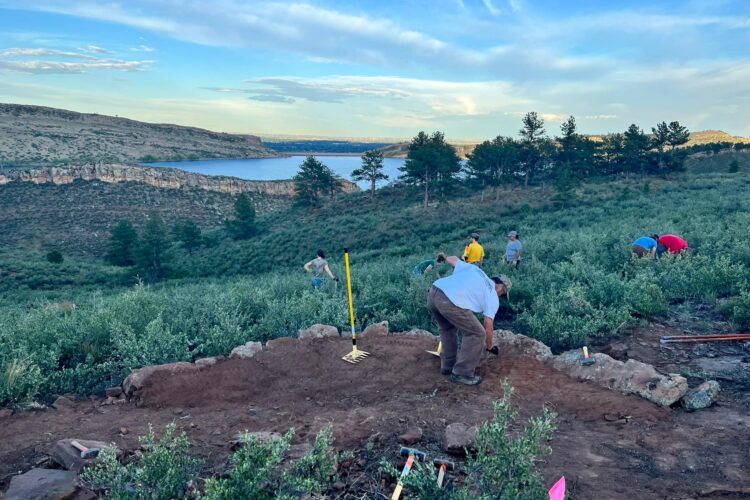
In anticipation of the coming volunteer season, Colorado Springs Parks and Recreation employees walk their trail networks every winter, examine issues, and compile a list of projects to tackle. The parks department knows social trails form over time from different user groups, but this past winter, they wanted to hone in on Red Rock Canyon Open Space and look more closely than ever.
“We had two seasonal employees with GPS units and they really took their time,” said Scott Abbot, the Parks and Recreation manager for the City of Colorado Springs. “They spent weeks, every day, walking all the trails that were not a part of the designated trail system, and until you really start doing that you don’t know the severity of how many there are.”
There are many terms for these types of trails: social, unsanctioned, rogue, desire, illegal, game. Abbot calls them “trails that shouldn’t be there,” and this year the park counted 60 miles in Red Rock Canyon.
“Interestingly enough, that’s not shocking,” said Abbot. Other parks in Colorado Springs have reached similar numbers. In 2000, they found a comparable amount in the Garden of the Gods, a popular hiking area near town. Often, the trails that shouldn’t be there are social trails, meandering trails, or shortcuts back to the car, created by hikers who see a quicker way to their destination.
Abbot said lately however, they are seeing more trails that are intentionally built. In an acquired piece of land attached to Blodgett Open Space, park officials encountered trail builders with tools building mountain bike features.
Abbot doesn’t want to pigeonhole user groups, since hikers, mountain bikers, and the wild, furry residents of the park have created trails to one degree or another, but he does make the connection to jumps or berms to illegally created mountain bike trails. The trail builders weren’t ticketed, but rather given a warning and “significant” education. Abbot explains that Parks and Recreation officials aren’t law enforcement representatives and rather use the “soft enforcement” approach of education.
Cory Sutela, the president of Medicine Wheel Trail Advocates sees the issue as a symptom of something greater: a result of actively closing mountain bike trails and a refusal to build mountain bike trails that are in a master plan.
“You can’t just go out on the city park and make your own trails,” said Sutela. “Our organization has an easy time supporting that position. You can’t just go create a new trail. At the same time, we’re seeing city staff refuse to build trails that are in a publicly approved master plan.”
Sutela believes that alludes to the greater issue.
“A big problem and the reason for illegal trails is that some land managers won’t proceed with any reasonable public process to appropriately assess the land and see what trails should be there.”
Abbott said he doesn’t have any knowledge of trails not being built and that the city is “well under way of implementing many new trails.”

When Colorado Springs Parks and Open Spaces acquired the most recent piece of land in 2021 which connects to Blodgett, there was an existing mountain bike trail the city closed. Sutela said riders enjoyed access to a fall-line style trail on the property for years, but as soon as Colorado Springs Parks and Recreation assumed management, the trail was closed. “Ultimately, the city can do that,” said Sutela, “but it escalates the conflict [between the City] and users.”
Abbott said the trail had been rerouted because it followed a drainage and they were concerned about erosion. He said he isn’t aware how the trail was managed previously.
Sutela said Medicine Wheel’s relationship with the city is mostly positive. Sutela was looking forward to opening a brand new pumptrack and bike skills park on city property. Yet, he’s frustrated by other instances where he has tried to establish a relationship and work with Parks and Recreation for improved mountain bike access or collaborative campaigning on illegal trail building, which the City of Colorado Springs worked with El Paso County and the U.S. Forest Service on.
As far as rehabilitating the unofficial trails in Red Rock Canyon, the City of Colorado Springs is tackling projects based on their importance. Issues that seem more prone to erosion or interfere with wildlife habitat are managed first. They’re trying user education and outreach first at trailheads or on social media, explaining to those who might be creating a trail, or using an unofficial trail, the impact they are having. They’ll also look at wayfinding signage through the park and use fencing as needed.
Signage and fencing is a balance of trying to manage resources while keeping the natural feel of the park, Abbott said. They are also joining with other organizations to get the message out. Teaming up with El Paso County and the U.S. Forest Service, the City of Colorado Springs released a short statement at the end of June.
“As our region continues to grow, it is crucial that we all work together to preserve and maintain these special places.”



















